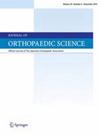手部前向 X 光片上锤骨体骨折患者腕掌关节的放射学特征。
IF 1.4
4区 医学
Q3 ORTHOPEDICS
引用次数: 0
摘要
背景:腕骨体骨折非常罕见,而且由于 X 光片诊断困难而容易被忽视。我们重点研究了腕掌关节间隙宽度(CMC-JSW),并在多功能手部前后位 X 光图像上检查了这种骨折的特征,这些图像最初是为手部创伤病例拍摄的:本研究纳入了 2013 年 1 月至 2023 年 10 月期间在我院经 CT 诊断为锤骨体骨折的 10 名患者(9 男 1 女,平均年龄 34 岁)。其中 6 例为背侧型骨折,4 例为剪切型骨折。第 4 和第 5 CMC-JSW 是通过手部前后位X光片和 CT 矢状切片测量的。如果掌骨和锤骨因凹陷而出现重叠,则宽度表示为负值(重叠符号)。采用 Mann-Whitney U 检验法比较受影响侧和未受影响侧的 CMC-JSW。与 X 光和 CT 测量值的相关性采用 Spearman 检验进行分析:X光片上锤骨体骨折的平均CMC-JSW(IV:-0.52 mm,V:-1.33 mm)为负值,这些值明显低于未受影响的一侧(IV:1.51 mm,V:1.48 mm)(P 结论:锤骨体骨折的平均CMC-JSW(IV:-0.52 mm,V:-1.33 mm)为负值:与CT矢状切面相关的CMC-JSW降低和手部前向X光片上的 "重叠征 "可能是锤骨体骨折的放射学特征。应注意避免因细微的 CMC-JSW 下降而忽略剪切型骨折。本文章由计算机程序翻译,如有差异,请以英文原文为准。
Radiological features of the carpometacarpal joint in hamate body fracture on anteroposterior hand X-ray image
Background
Hamate body fractures are rare and can be overlooked due to the diagnostic difficulty on X-ray. We focused on the carpometacarpal joint space width (CMC-JSW) and examined the features of this fracture on versatile anteroposterior hand X-ray images, initially taken for hand trauma cases.
Methods
Ten patients (nine males and one female; mean age, 34 years) diagnosed with a hamate body fracture on CT in our facility between January 2013 and October 2023 were included in this study. The fracture types were dorsal type in six cases and shear type in four cases. The 4th and 5th CMC-JSWs were measured on anteroposterior hand radiography and CT sagittal sections. If the metacarpal and hamate bones appeared to overlap due to depression, the width was expressed as a negative value (overlap sign). CMC-JSWs were compared between the types or unaffected sides using the Mann–Whitney U test. The correlation with X-ray and CT measurements was analyzed using the Spearman test.
Results
The average CMC-JSWs (IV: −0.52 mm, V: −1.33 mm) in hamate body fractures on X-ray were minus and these values were significantly lower than unaffected side (IV: 1.51 mm, V: 1.48 mm) (p < 0.05, p < 0.001). CMC-JSW (IV: −1.64 mm) and CMC-JSW (V: −2.70 mm) of dorsal type were significantly lower than shear type (IV: 1.17 mm, V: 0.72 mm) (p < 0.05). CMC-JSW values on X-ray were positively correlated with those on CT (IV: ρ = 0.796, V: ρ = 0927).
Conclusions
Decreased CMC-JSW, correlated with CT sagittal sections, and “overlap sign” on anteroposterior hand X-ray were possible radiological characteristics of hamate body fracture. Care should be taken to avoid overlooking shear-type fractures because of subtle CMC-JSW decreases.
求助全文
通过发布文献求助,成功后即可免费获取论文全文。
去求助
来源期刊

Journal of Orthopaedic Science
医学-整形外科
CiteScore
3.00
自引率
0.00%
发文量
290
审稿时长
90 days
期刊介绍:
The Journal of Orthopaedic Science is the official peer-reviewed journal of the Japanese Orthopaedic Association. The journal publishes the latest researches and topical debates in all fields of clinical and experimental orthopaedics, including musculoskeletal medicine, sports medicine, locomotive syndrome, trauma, paediatrics, oncology and biomaterials, as well as basic researches.
 求助内容:
求助内容: 应助结果提醒方式:
应助结果提醒方式:


